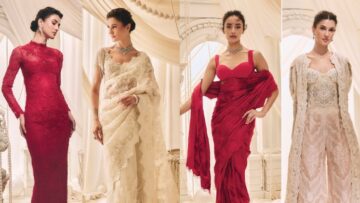The Indian womenswear market is in the midst of a dynamic shift, driven by rapid urbanisation, rising disposable incomes and an evolving consumer mindset that increasingly favours contemporary fashion. Furthermore, the sky rocketing influence of digital platforms and social media has further accelerated this transformation, allowing global trends to seamlessly integrate with local sensibilities.
In 2023, the Indian apparel market witnessed an 8.3 per cent growth, reaching Rs. 6,996 billion. However, 2024 saw a slight deceleration due to inflationary pressures. Despite this, the digital fashion segment continued to thrive, with online apparel sales rising by 15.9 per cent. This upward trend is expected to persist as improved digital infrastructure and a growing tech-savvy consumer base drive further adoption.
As Rahul Bhalla, CEO and Co-founder of Latin Quarters, observes, “The Indian women’s fashion market is expanding due to multiple factors. Urbanisation and higher disposable incomes have broadened the consumer base seeking stylish apparel. Social media and e-commerce have amplified awareness and accessibility, increasing demand for ready-to-wear western fashion.”
Indian consumers are becoming more discerning, prioritising quality over sheer volume. A McKinsey report highlights that 66 per cent of shoppers now prefer to invest in fewer, higher-quality pieces, emphasising longevity and value. This shift has paved the way for the rise of ‘quiet luxury’— a movement centred on understated elegance, premium materials and exceptional craftsmanship over inthe-face branding.
Another key trend is the demand for versatile fashion that blends aesthetics with functionality. “For Fall/Winter 2025, we anticipate a growing preference for hybrid workwear and refined loungewear,” says Rahul Bhalla, adding, “Expect to see structured yet comfortable silhouettes like oversized blazers, wide-leg trousers and knit co-ord sets. Midi dresses designed for layering and effortlessly chic jumpsuits will also be key wardrobe staples.”
| Consumers are demonstrating a willingness to invest in craftsmanship, ethically sourced materials and unique design elements, reinforcing the importance of value-driven pricing strategies. |
With inflationary challenges impacting supply chains worldwide, brands are adopting more nuanced pricing models. While price sensitivity remains a crucial factor affecting decisions in the Indian market, the appetite for premium fashion is steadily increasing. The demand for aspirational yet accessible luxury is on the rise, allowing mid-tier and bridge-toluxury brands to bloom.
Key Trends for Fall/Winter 2025
Outerwear is in the limelight this season, with statement pieces leading the way. Luxe silky bombers, faux furs and caped silhouettes redefine winter layering. Draped coats, shawl collars and funnel-neck designs bring an air of sophistication, while scarf coats emerge as a chic yet practical choice. Structured tailoring returns in full force, with belted coats and exaggerated shoulders adding a bold, confident edge to ensembles.
While TikTok and social media continue to spotlight trends like ‘quiet luxury’ and ‘trad-wives’, designers are also pushing the boundaries of traditional femininity. Androgynous tailoring, gender-fluid silhouettes and deconstructed suiting reflect a more progressive approach, challenging conventional definitions of womenswear.
After multiple seasons of body conscious dressing, Fall/Winter 2025 shifts towards fluidity and volume. High-neck sweaters, wideleg trousers and long-line skirts dominate collections, creating a refined yet effortless aesthetic. Textural elements such as fringing, frayed hems and exposed seams add depth, while layering remains a key styling approach, particularly across dresses and outerwear.
With work-life boundaries continuing to blur, hybrid workwear remains in demand. Oversized blazers, structured midi skirts and soft knit co-ords seamlessly transition between professional and casual settings. Peplums quietly re-emerge, lending an architectural flair to blouses and tailored separates.
In terms of fabrics, the season is defined by rich textures and elevated materials. Velvet, brushed wools and boucle take centre stage, while luxurious leather and suede remain staple elements. Cashmere and heavyweight knits reinforce the season’s cocooning aesthetic. For eveningwear, crystal embellishments and delicate beading bring an understated sense of glamour, elevating both day-to-night ensembles and formal attire.
The season’s colour story leans into depth and sophistication with black continuing its reign as the epitome of quiet luxury, exuding mystery and refinement alongside rich berry tones. Earthy tones such as caramel, chocolate and olive provide warmth, while deep yellow offers a subtle yet striking contrast. Monochromatic dressing remains dominant, allowing silhouettes and textures to remain the focal point of attraction.
In the accessories department, we see knee-high and riding boots make a strong comeback, reinforcing the season’s equestrian influences. TA style to note is the Prada loafer-boot hybrid that signals a shift towards practical yet stylish footwear. Meanwhile, handbags take a nostalgic turn, with the revival of iconic styles like Prada’s bowling bag and Fendi’s Spy Bag, cementing their status as must-have investment pieces. Bag charms further emerge as a high in demand item, perfect to be paired with a slew of bag styles across the mix.
Final Takeaway
As the Indian womenswear market gears up for Fall/Winter 2025, brands and retailers must stay attuned to evolving consumer expectations. The key to success lies in offering quality-driven, texture-rich materials and versatile silhouettes that align with the season’s themes of quiet luxury and functional elegance. If brands can pay attention to integrating wearability with subtle opulence and timeless design, brands can effectively position themselves within an ever-changing fashion landscape while catering to an increasingly sophisticated audience.
Womenswear Market Outlook by Rahul Bhalla, CEO and Co-founder, Latin Quarters
Latin Quarters has established itself as a premium western wear brand for modern women, embodying both style and quality since its inception in 2006. With a strong commitment to size inclusivity, the brand celebrates women in their true form under the motto ‘Real Fit, Real You’.
Offering an eclectic mix of casual and occasionwear, the brand curates collections inspired by global trends and distributes them through an extensive retail network. Its expansive presence spans over 400 stores across 78 cities in India, ensuring accessibility to a broad consumer base.
Specialising in premium women’s westernwear, Latin Quarters provides a comprehensive wardrobe solution that includes tops, dresses, bottoms, shrugs, sweaters, jackets, skirts and jumpsuits. The brand also offers a selection of accessories and handbags to complement its apparel. With prices starting at Rs.1,499, the collection is designed to make high-quality, trendy fashion accessible to style-conscious women who seek contemporary designs that align with their dynamic lifestyles.
As the industry looks ahead to Fall/ Winter 2025, Rahul Bhalla, CEO and Co-founder of Latin Quarters, shares his exclusive insights with Apparel Resources on the evolving womenswear landscape, offering a glimpse into the key trends and innovations shaping the upcoming season.
AR: Highlight some of the best-selling products of the current season and the factors that contributed to their success.
RB: This season, our floral maxi dresses, breezy tops and premium party dresses have emerged as bestsellers like our green v-neck cap-sleeve printed A-line dress, black v-neck sleeveless solid A-line-dress and green cap-sleeve collar neck floral print crop blouse. The success of these items can be attributed to their alignment with current fashion trends, the use of high-quality materials such as lightweight georgettes, breathable cotton blends, soft chiffons and satins, offering both comfort and style. Additionally, our commitment to providing value through accessible pricing has resonated with our customers, further driving the popularity of these products.
AR: What strategies does Latin Quarters employ to make womenswear fashion more affordable for a broader audience at an accessible price point without compromising on quality?
RB: Firstly, we leverage business intelligence tools to analyse customer preferences, enabling us to design products that align with market demands efficiently. Secondly, the adoption of 3D CAD technology has revolutionised our product development process, minimised wastage and reduced lead times. Additionally, we offer attractive discounts during festive seasons and end-of-season sales, allowing customers to invest in premium fashion at better value.
Beyond pricing, we engage in impactful social media campaigns and influencer collaborations to enhance brand visibility. Campaigns like Dear Maa celebrate personal stories, while partnerships with fashion influencers make our collections aspirational yet relatable.
Embracing sustainability, we introduced Revive, a recycled collection that transforms waste into stylish, high-quality fashion. Revive reflects our commitment to eco-conscious luxury, allowing customers to make sustainable choices without compromising on style or quality. Through strategic sourcing and streamlined operations, we continue to deliver premium fashion at wellpriced value.
AR: What, according to you, is driving consumption in women’s fashion categories in the Indian market?
RB: The Indian women’s fashion market is experiencing growth driven by several factors. Increased urbanisation and rising disposable incomes have expanded the consumer base seeking fashionable apparel. Additionally, the influence of global fashion trends, amplified by social media and digital platforms, has heightened awareness and desire for contemporary styles. The convenience of online shopping and a growing preference for ready-to-wear western apparel have also significantly contributed to this upward consumption trend.
AR: What are the emerging consumer preferences or trends that you think will impact purchasing decisions for womenswear in Fall/Winter 2025?
RB: As we look ahead to Fall/ Winter 2025, we anticipate a shift towards sustainable and versatile fashion choices. Consumers are becoming increasingly conscious of environmental impacts, leading to a preference for eco-friendly materials and ethical production practices. There is also a growing demand for timeless pieces that offer versatility, allowing for multiple styling options and extended wear. Comfort continues to be a priority, with an emphasis on relaxed yet polished silhouettes that cater to both professional and casual settings.
AR: What are the emerging product categories or silhouettes in the womenswear segment that you anticipate gaining traction in the upcoming Fall/Winter 2025 season?
RB: In the upcoming Fall/Winter 2025 season, we foresee a rise in popularity for tailored loungewear and hybrid workwear that seamlessly blend comfort with professionalism. Silhouettes featuring oversized blazers, wide-leg trousers and knit co-ord sets are expected to gain traction. Additionally, midi dresses with layering potential and versatile jumpsuits that transition effortlessly from day to night will likely become wardrobe staples for many consumers.
AR: What are the optimal price points for womenswear pieces that Latin Quarters is operating on in the Fall/Winter 2025 season? Are there specific price points that you believe will perform well in the upcoming season?
RB: For the Fall/Winter 2025 season, Latin Quarters plans to maintain its accessible pricing strategy, with key pieces ranging from Rs. 1,499 to Rs. 4,999. We believe that Rs. 2,000 to Rs. 3,000 price bracket will perform particularly well, as it offers a balance between affordability and perceived value. This range allows customers to invest in quality garments without overextending their budgets, aligning with the growing consumer preference for mindful spending on versatile and durable fashion items.
AR: In terms of consumer demand, what are the particular styles, colour palettes or design elements in women’s fashion that you anticipate being in high demand for the upcoming Fall/ Winter season?
RB: There will be a demand for classic styles with modern twists. Neutral colour palettes such as navy, charcoal and earthy tones are expected to dominate, complemented by subtle design elements like textured fabrics and minimalist detailing. Comfortdriven styles and versatile layering pieces, are also anticipated to be in high demand as consumers continue to prioritise both style and comfort.
AR: Which materials do you recommend investing in for the F/W ’25 season?
RB: For F/W ’25 season, investing in sustainable and high-quality materials is advisable. Fabrics such as organic cotton, linen, satin, recycled polyester and Tencel not only offer comfort and durability but also align with the increasing consumer demand for ecofriendly products. Breathable cotton and airy georgettes provide versatility for transitional layering, while chiffons and satins bring fluidity and elegance to eveningwear. Additionally, velvet adds a touch of opulence, while quilted and padded textiles enhance both warmth and style, ensuring a perfect blend of functionality and sophistication.
AR: What do you consider as must-have products or wardrobe essentials to include in one’s assortment for F/W ’25?
RB: F/W ’25 is all about effortless sophistication and versatile styling. Must-have wardrobe essentials include satin skirts, long white skirts and co-ord sets—trending pieces that offer both elegance and ease. A satin dress is a party season staple, adding instant glamour to any look. Printed short blouses are another key addition, pairing seamlessly with satin and pleated skirts for a polished yet stylish ensemble. These trends are dominating fashion spaces, from Pinterest to street style, proving that chic, well-curated pieces are the foundation of a standout wardrobe this season.
AR: What do you have to say about the consumer’s shift in perception from quantity to quality?
RB: Consumers today are making a conscious shift from quantity to quality, focusing on investment pieces rather than impulse-driven, disposable fashion. This change is driven by an increased awareness of sustainability, a demand for better craftsmanship and a preference for timeless designs that offer long-term wearability. Instead of frequently replacing garments, shoppers are now looking for pieces that are well constructed, versatile and made from high-quality fabrics that retain their appeal over multiple seasons.
Instead of fast-changing trends, consumers are drawn to timeless silhouettes, functional layering pieces and transitional outfits that seamlessly move from day to night or season to season. As a result, we design collections that offer both wardrobe essentials and statement pieces, ensuring that customers get the most out of every purchase.








